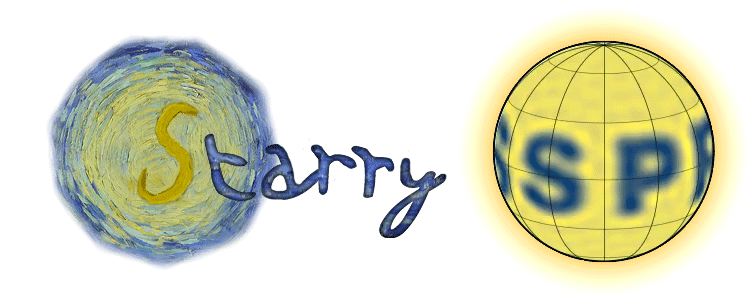可解释的高斯过程用于恒星光变曲线
项目描述
使用 starry 的可解释高斯过程来处理恒星光变曲线。
恒星变星的高斯过程
代码 starry_process 实现了一个可解释的高斯过程 (GP) 来模拟恒星光变曲线。无论您的目标是边缘化恒星变星信号(如果您将其视为噪声)还是理解产生它的表面特征(如果您将其视为数据),此代码都适用于您。这里实现的高斯过程与您可能在分析中使用的任何其他高斯过程一样工作,但其超参数是 物理可解释的。这些参数包括(但不限于)斑点半径,纬度分布的均值和方差,斑点对比度 和 斑点数量。用户还可以指定像恒星的自转周期、边缘暗化参数和倾角(如果不知道,可以边缘化倾角)等。
代码是用Python编写的,依赖于 Theano包,因此建议您对此有所了解。请查看 这里 的快速入门教程。如果您想报告问题或为项目做出贡献,请查看 CONTRIBUTING.md。
安装
最快的方式是通过 pip
pip install starry-process
请注意,starry_process 包需要Python 3.6或更高版本。
快速入门
导入主接口
from starry_process import StarryProcess
从具有小中纬度斑点的高斯过程抽取样本
import numpy as np
import matplotlib.pyplot as plt
# Instantiate the GP
sp = StarryProcess(
r=10, # spot radius in degrees
mu=30, # central spot latitude in degrees
sigma=5, # latitude std. dev. in degrees
c=0.1, # fractional spot contrast
n=10 # number of spots
)
# Draw & visualize a spherical harmonic sample
y = sp.sample_ylm().eval()
sp.visualize(y)
# Compute & plot the flux at some inclination
t = np.linspace(0, 4, 1000)
flux = sp.flux(y, t, i=60).eval()[0]
plt.plot(t, flux)

与上面相同,但用于高纬度斑点
sp = StarryProcess(r=10, mu=0, sigma=10, c=0.1, n=10)

大赤道斑点
sp = StarryProcess(r=30, mu=0, sigma=10, c=0.1, n=10)

小,近似各向同性的斑点
sp = StarryProcess(r=10, mu=0, sigma=40, c=0.1, n=10)

参考文献 & 归因
代码的描述见此JOSS论文。它是Mapping Stellar Surfaces论文系列的核心,包括
如果您在研究中使用了此代码,请引用
@article{Luger2021a,
author = {{Luger}, Rodrigo and {Foreman-Mackey}, Daniel and {Hedges}, Christina and {Hogg}, David W.},
title = {{Mapping stellar surfaces I: Degeneracies in the rotational light curve problem}},
journal = {arXiv e-prints},
keywords = {Astrophysics - Solar and Stellar Astrophysics, Astrophysics - Instrumentation and Methods for Astrophysics},
year = 2021,
month = jan,
eid = {arXiv:2102.00007},
pages = {arXiv:2102.00007},
archiveprefix = {arXiv},
eprint = {2102.00007},
primaryclass = {astro-ph.SR},
adsurl = {https://ui.adsabs.harvard.edu/abs/2021arXiv210200007L},
adsnote = {Provided by the SAO/NASA Astrophysics Data System}
}
@article{Luger2021b,
author = {{Luger}, Rodrigo and {Foreman-Mackey}, Daniel and {Hedges}, Christina},
title = {{Mapping stellar surfaces II: An interpretable Gaussian process model for light curves}},
journal = {arXiv e-prints},
keywords = {Astrophysics - Solar and Stellar Astrophysics, Astrophysics - Earth and Planetary Astrophysics, Astrophysics - Instrumentation and Methods for Astrophysics},
year = 2021,
month = feb,
eid = {arXiv:2102.01697},
pages = {arXiv:2102.01697},
archiveprefix = {arXiv},
eprint = {2102.01697},
primaryclass = {astro-ph.SR},
adsurl = {https://ui.adsabs.harvard.edu/abs/2021arXiv210201697L},
adsnote = {Provided by the SAO/NASA Astrophysics Data System}
}
@article{Luger2021c,
author = {{Luger}, Rodrigo and {Foreman-Mackey}, Daniel and {Hedges}, Christina},
title = {{starry\_process: Interpretable Gaussian processes for stellar light curves}},
journal = {arXiv e-prints},
keywords = {Astrophysics - Solar and Stellar Astrophysics, Astrophysics - Earth and Planetary Astrophysics, Astrophysics - Instrumentation and Methods for Astrophysics},
year = 2021,
month = feb,
eid = {arXiv:2102.01774},
pages = {arXiv:2102.01774},
archiveprefix = {arXiv},
eprint = {2102.01774},
primaryclass = {astro-ph.SR},
adsurl = {https://ui.adsabs.harvard.edu/abs/2021arXiv210201774L},
adsnote = {Provided by the SAO/NASA Astrophysics Data System}
}
项目详情
下载文件
下载适合您平台的文件。如果您不确定选择哪个,请了解更多关于安装包的信息。
源代码分发
starry_process-0.9.8.tar.gz (28.4 MB 查看散列)
构建分发
starry_process-0.9.8-py3-none-any.whl (22.8 MB 查看散列)
关闭
starry_process-0.9.8.tar.gz的散列
| 算法 | 散列摘要 | |
|---|---|---|
| SHA256 | 08efa894d60b45a6865be846900484c3f982bc949dbaae304e2216d8e1d6b2fe |
|
| MD5 | 1a8df35fb2de5e06df5677d5a1c93e9a |
|
| BLAKE2b-256 | 5d7aac8850c381acc5dd0ed70dc6a15ffedf9318963c8907794c91c73570ec06 |
关闭
starry_process-0.9.8-py3-none-any.whl的散列
| 算法 | 散列摘要 | |
|---|---|---|
| SHA256 | 80fd242f2a630bbb0b80500a728f4a9c9c4f624afbfbd7731b1820460a4615e6 |
|
| MD5 | e065f39af7a425706d3f4d2eab8f93d8 |
|
| BLAKE2b-256 | 9bc6b3fdb51c6ace7bd5f09a5d1baaa67b980e91fa1c84144de21c3dd9852c5a |










